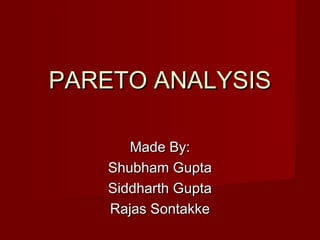
Qcl 15-v4 [challenge-no 4 pareto graph]_[imnu]_[shubham gupta]
- 1. PARETO ANALYSISPARETO ANALYSIS Made By:Made By: Shubham GuptaShubham Gupta Siddharth GuptaSiddharth Gupta Rajas SontakkeRajas Sontakke
- 2. Pareto analysis is a formal techniquePareto analysis is a formal technique useful where many possible courses ofuseful where many possible courses of action are competing for attention.action are competing for attention.
- 3. Pareto analysis is a creative way ofPareto analysis is a creative way of looking at causes of problems because itlooking at causes of problems because it helps stimulate thinking and organizehelps stimulate thinking and organize thoughts.thoughts.
- 4. This technique helpsThis technique helps to identify the topto identify the top 20% of causes that20% of causes that needs to beneeds to be addressed to resolveaddressed to resolve the 80% of thethe 80% of the problems.problems.
- 5. The value of the Pareto Principle for a projectThe value of the Pareto Principle for a project manager is that it reminds you to focus on themanager is that it reminds you to focus on the 20% of things that matter. Of the things you do20% of things that matter. Of the things you do during your project, only 20% are reallyduring your project, only 20% are really important. Those 20% produce 80% of yourimportant. Those 20% produce 80% of your results. Identify and focus on those things first,results. Identify and focus on those things first, but don't totally ignore the remaining 80% ofbut don't totally ignore the remaining 80% of causes.causes.
- 6. History of Pareto AnalysisHistory of Pareto Analysis The Pareto effect is named after VilfredoThe Pareto effect is named after Vilfredo Pareto, an economist and sociologist whoPareto, an economist and sociologist who lived from 1848 to 1923.lived from 1848 to 1923.
- 7. HOW TO USE IT ?HOW TO USE IT ?
- 8. Step 1: Identify and List ProblemsStep 1: Identify and List Problems Step 2: Identify the Root Cause of EachStep 2: Identify the Root Cause of Each ProblemProblem Step 3: Score ProblemsStep 3: Score Problems Step 4: Group Problems Together By RootStep 4: Group Problems Together By Root CauseCause Step 5: Add up the Scores for Each GroupStep 5: Add up the Scores for Each Group Step 6: Take ActionStep 6: Take Action
- 9. The Pareto ChartThe Pareto Chart A Pareto chartA Pareto chart is a graphicalis a graphical representationrepresentation that displaysthat displays data in orderdata in order of priority.of priority.
- 10. There are many waste types defined by modern systems of waste management, notably including: Municipal waste includes Household waste, Commercial waste, and Demolition waste Hazardous waste includes Industrial waste Biomedical waste includes clinical waste Special Hazardous waste includes Radioactive waste, explosives waste, and
- 11. Surface water contamination: Waste that ends up in water bodies negatively change the chemical composition of the water. Technically, this is called water pollution. This will affect all ecosystems existing in the water. It can also cause harm to animals that drink from such polluted water. Soil contamination: Hazardous chemicals that get into the soil (contaminants) can harm plants when they take up the contamination through their roots. If humans eat plants and animals that have been in contact with such polluted soils, there can be negative impact on their health. Pollution: Bad waste management practices can result in land and air pollution and can cause respiratory problems and other adverse health effects as contaminants are absorbed from the lungs into other parts of the body. Ill Effects of Garbage and Waste
- 12. Sources of waste quantity(in metric tons) cumulative frequency % cumulative frequency paper 878 878 19.80% food scraps 786 1664 37.53% yard trimming 601 2265 51.08% plastics 558 2823 63.67% metals 432 3255 73.41% rubber,textile,leather 386 3641 82.12% wood 303 3944 88.95% glass 283 4227 95.33% others 207 4434 100.00% Types of Garbage in the City
- 13. Pareto Graph
- 14. By Pareto analysis (80/20 rule)we conclude that the major causes of garbage in cities are as follows: 1. Paper 2. Food scraps 3. Yard trimming 4. Plastics 5. Metals
- 15. Solutions Landfill Disposal of waste in a landfill involves burying the waste and this remains a common practice in most countries. Landfills were often established in abandoned or unused quarries, mining voids or borrow pits. A properly designed and well-managed landfill can be a hygienic and relatively inexpensive method of disposing of waste materials. Incineration Incineration is a disposal method in which solid organic wastes are subjected to combustion so as to convert them into residue and gaseous products. This method is useful for disposal of residue of both solid waste management and solid residue from waste water management. This process reduces the volumes of solid waste to 20 to 30 percent of the original volume. Recyclin gRecycling is a resource recovery practice that refers to the collection and reuse of waste materials such as empty beverage containers. The materials from which the items are made can be reprocessed into new products. Pyrolysis Pyrolysis is a process of thermo-chemically decomposition of organic materials by heat in the absence of oxygen which produces various hydrocarbon gases. During pyrolysis, the molecules of object are subjected to very high temperatures leading to very high vibrations. Therefore every molecule in the object is stretched and shaken to an extent that molecules starts breaking down.
- 16. Lessons learnt The team learnt the importance of pareto analysis when many possible courses of action are competing for attention. We learnt the importance of Pareto diagrams in our daily lives and its utilization. The team learnt via Pareto diagram that focusing efforts on the ‘vital few’ causes is usually a better use of valuable resourses.